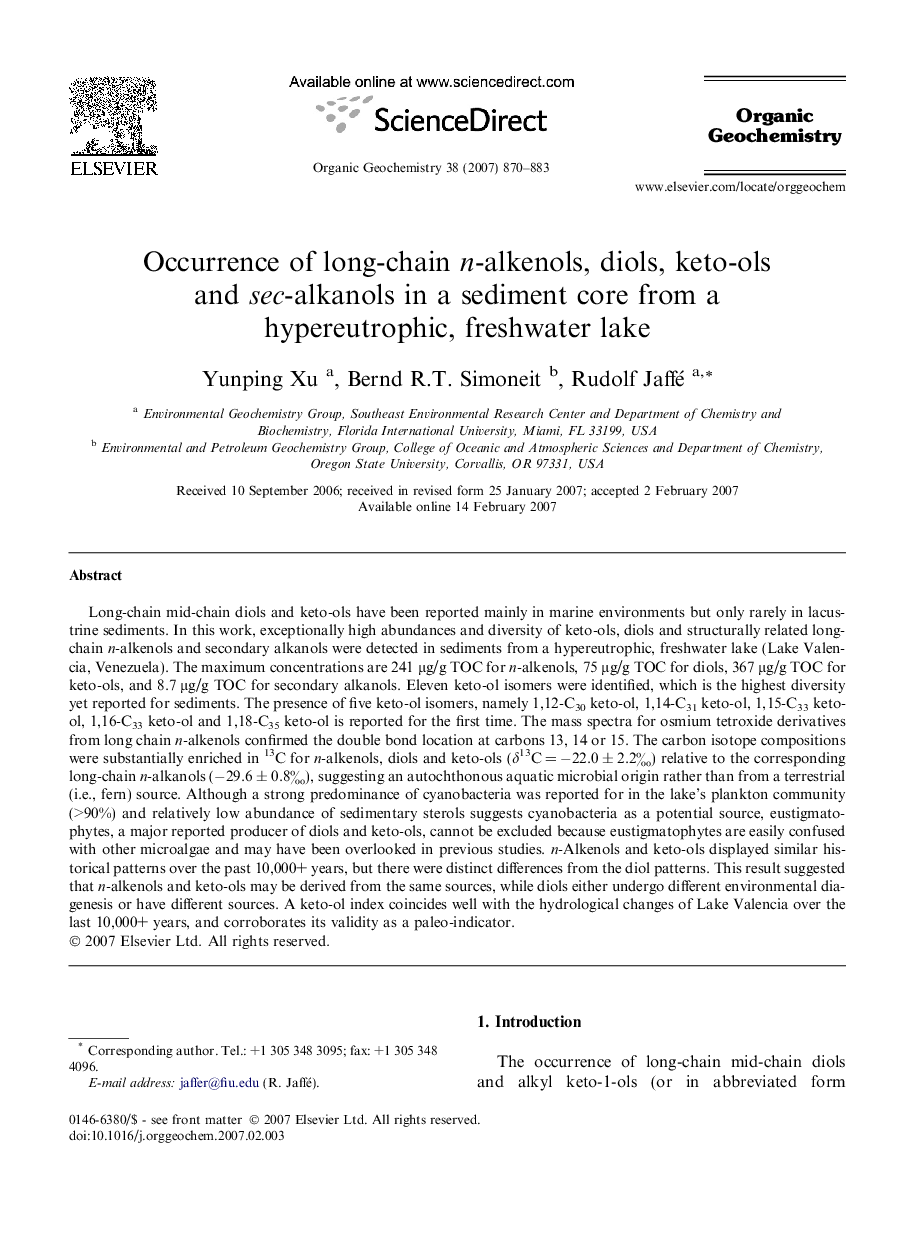| کد مقاله | کد نشریه | سال انتشار | مقاله انگلیسی | نسخه تمام متن |
|---|---|---|---|---|
| 5162092 | 1379672 | 2007 | 14 صفحه PDF | دانلود رایگان |
عنوان انگلیسی مقاله ISI
Occurrence of long-chain n-alkenols, diols, keto-ols and sec-alkanols in a sediment core from a hypereutrophic, freshwater lake
دانلود مقاله + سفارش ترجمه
دانلود مقاله ISI انگلیسی
رایگان برای ایرانیان
موضوعات مرتبط
مهندسی و علوم پایه
شیمی
شیمی آلی
پیش نمایش صفحه اول مقاله

چکیده انگلیسی
Long-chain mid-chain diols and keto-ols have been reported mainly in marine environments but only rarely in lacustrine sediments. In this work, exceptionally high abundances and diversity of keto-ols, diols and structurally related long-chain n-alkenols and secondary alkanols were detected in sediments from a hypereutrophic, freshwater lake (Lake Valencia, Venezuela). The maximum concentrations are 241 μg/g TOC for n-alkenols, 75 μg/g TOC for diols, 367 μg/g TOC for keto-ols, and 8.7 μg/g TOC for secondary alkanols. Eleven keto-ol isomers were identified, which is the highest diversity yet reported for sediments. The presence of five keto-ol isomers, namely 1,12-C30 keto-ol, 1,14-C31 keto-ol, 1,15-C33 keto-ol, 1,16-C33 keto-ol and 1,18-C35 keto-ol is reported for the first time. The mass spectra for osmium tetroxide derivatives from long chain n-alkenols confirmed the double bond location at carbons 13, 14 or 15. The carbon isotope compositions were substantially enriched in 13C for n-alkenols, diols and keto-ols (δ13C = â22.0 ± 2.2â°) relative to the corresponding long-chain n-alkanols (â29.6 ± 0.8â°), suggesting an autochthonous aquatic microbial origin rather than from a terrestrial (i.e., fern) source. Although a strong predominance of cyanobacteria was reported for in the lake's plankton community (>90%) and relatively low abundance of sedimentary sterols suggests cyanobacteria as a potential source, eustigmatophytes, a major reported producer of diols and keto-ols, cannot be excluded because eustigmatophytes are easily confused with other microalgae and may have been overlooked in previous studies. n-Alkenols and keto-ols displayed similar historical patterns over the past 10,000+ years, but there were distinct differences from the diol patterns. This result suggested that n-alkenols and keto-ols may be derived from the same sources, while diols either undergo different environmental diagenesis or have different sources. A keto-ol index coincides well with the hydrological changes of Lake Valencia over the last 10,000+ years, and corroborates its validity as a paleo-indicator.
ناشر
Database: Elsevier - ScienceDirect (ساینس دایرکت)
Journal: Organic Geochemistry - Volume 38, Issue 6, June 2007, Pages 870-883
Journal: Organic Geochemistry - Volume 38, Issue 6, June 2007, Pages 870-883
نویسندگان
Yunping Xu, Bernd R.T. Simoneit, Rudolf Jaffé,